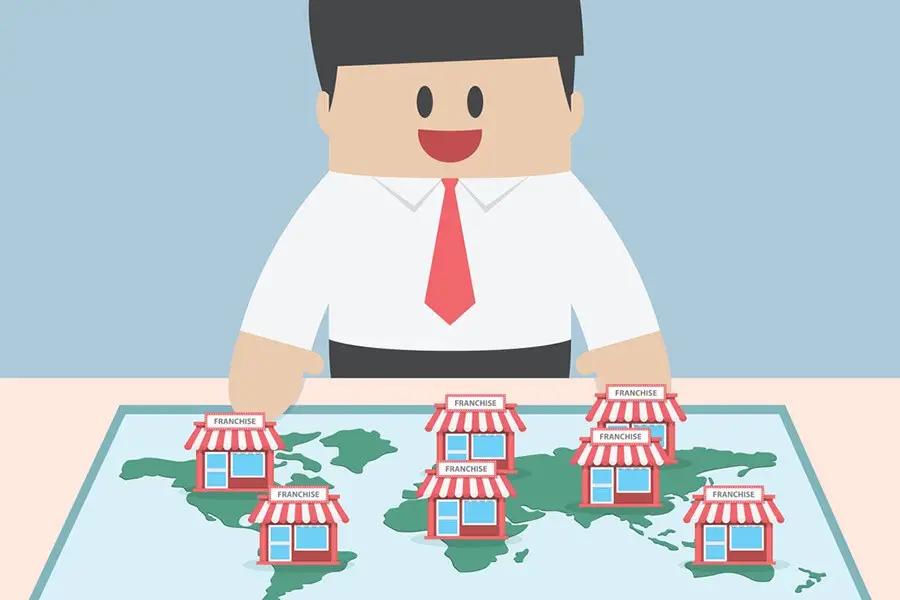The franchise format creates a special business model in which one business partner (franchisor) grants another (franchisee) the right to use a trademark, technologies, instructions, service standards, and business system. The concept is based on licensing and repeatability, where an entrepreneur implements a proven model with minimal risks. Therefore, what is a franchise is a ready-made business entry strategy with predictable results.
The franchisor provides knowledge, brand, training, access to IT systems, marketing support, and quality control. The franchisee pays a one-time initial fee and royalties monthly. Both parties work towards mutual growth, maintaining clear business distance and responsibilities.

### Rules for launching a franchise: what it is and how it works
The format requires clear structuring. The franchisee does not receive a ready-made business but implements a model according to approved standards. The system includes a legal agreement, a business case, guidelines, corporate support, and employee training. The brand ensures recognition, while the partner adheres to the regulations. The franchisor scales the network, and the entrepreneur reduces market entry risks.
#### Legal Foundations
The agreement documents key elements: territory, duration, types of products or services, personnel requirements, reporting forms, sanctions for violations. Regular audits, mystery shopping, CRM reports are mandatory control elements. The legal side protects everyone: the partner retains rights, the franchisor controls quality. Participants adhere to the contract supported by the Civil Code (Chapter 54, RF).
#### Franchise Economics
The model outlines three key payment streams: initial fee, monthly royalties, marketing fees. The commission ranges from 100,000 to 5,000,000 ₽ depending on the brand. Royalties range from 3–10% of turnover. Additional fees include contributions to general advertising, app support, IT maintenance. The payback period depends on the category, averaging from 6 to 24 months. Therefore, the answer to what a franchise is an investment with built-in return mathematics.
### Types of franchises by model
Understanding formats helps choose the optimal model for business goals. Varieties of franchises determine the level of commitments, investments, and autonomy:
1. **Product-based**: The manufacturer grants the right to distribute products under the brand. Example: “Apple Premium Reseller.” The franchisee does not change the product but organizes sales in the required format. Popular in technology, FMCG, fashion segments.
2. **Production**: The franchisee receives recipes, instructions, equipment. Produces products independently. Example: Coca-Cola — local plants produce drinks under license. Suitable for food, chemical, pharmaceutical markets.
3. **Service-based**: Not a product but a service is transferred: haircut, massage, training, rental. Example: “Like Center” studios, “Skyeng” schools. Service is controlled, not the product. Dominant in educational and beauty networks.
4. **Mobile**: Business operates without a fixed location. Example: mobile car washes, food trucks, “wheels delivery.” Minimal investments, high flexibility, rapid scalability.
5. **Investment**: The format involves a third-party manager. The franchisee is an investor who invests capital and receives reports. More commonly used in hotels and restaurants.
6. **Master franchise**: The franchisee receives the right to develop the network in a specific territory. Controls sub-franchisees. Requires significant capital and experience. Used by international brands: KFC, McDonald’s.
7. **Digital**: The product is entirely digital: online courses, services, applications. Example: a license to launch an LMS platform with content and CRM. Low costs, global coverage, quick setup.
Each format reveals a specific aspect of the approach. The specific choice depends on capital, competencies, goals, and launch time. It can be said that a franchise is not a universal solution but a flexible tool with dozens of modifications.
### How to choose the right format
Optimizing the starting path requires analysis. When choosing, consider:
– Entry level (capital);
– Readiness for operational management;
– Industry competencies;
– Goals (income, scaling, passive income).
A novice entrepreneur often chooses a service or product franchise with a simple entry. An experienced one may opt for a master model or production. Analyzing niche ratings, financial modules, competitor cases helps make an objective choice. A well-founded decision shortens the path to the first profit by 30–50%.
### Mistakes when launching a franchise
Mistakes when launching a franchise often occur not for technical reasons but due to ignoring the strategic base outlined in the documentation package. The main failure is underestimating the importance of internal standards. The franchisor provides a detailed set of regulations: instructions, brand book, scripts, checklists, service protocols. Deviating from these points undermines trust, reduces efficiency, and leads to sanctions. The brand starts to perceive the point as vulnerable, blocks access to training, denies marketing support. Violating rules is not a trivial matter but a critical blow to the reputation of both parties. Cases confirm that a franchise is primarily about precise compliance with regulations, not a loose interpretation of recommendations.
The second typical mistake is overestimating the brand. A strong logo does not replace real management. Even a successful national network does not guarantee an incoming flow without efforts on-site. Opening in an unprepared region, lack of local marketing, insufficient staff control nullify the franchise’s reputation power. The partner starts to rely on the magic of the name, ignoring operational tasks. Such an approach renders the essence of franchising useless.

The third failure occurs during calculations. Without financial modeling, the partner enters the project without understanding the breakeven point. Seasonality, logistics, depreciation, labor costs, taxes, hidden expenses are ignored. As a result, even with normal sales flow, the project goes into the red. The error occurs at the start due to a lack of deep planning. Therefore, even before signing the contract, it is necessary to create a P&L model, consider three scenarios (optimistic, basic, pessimistic), assess profitability through ROI and payback period. It is crucial to understand that a franchise is not just a contract with a brand but a business with financial responsibilities and figures at the entrance.
### Conclusions
Franchising proves its effectiveness as a way to scale a brand and enter business. The model combines standardization, delegation, and support. The franchisee receives a ready-made business algorithm. The franchisor scales the brand without investing in points. As a result, both parties build a sustainable partnership. It can be said that a franchise is a growth mechanism where each element works in conjunction.
 en
en  ru
ru  de
de  ar
ar  es
es  hi
hi  fr
fr  nl
nl  it
it  pt
pt  el
el 



